Motion Study: Boost Efficiency and Reduce Waste
In today’s competitive industrial environment, optimizing every aspect of operational efficiency is no longer optional — it’s essential. One of the most effective and time-tested methods for doing so is motion study.
Motion study is the systematic analysis of the movements involved in performing a task. By examining every action — from the most basic hand motion to the full-body mechanics of a worker — it aims to eliminate wasteful effort, streamline workflows, and improve productivity. As part of the broader concept of work and motion study, this technique focuses not just on how long tasks take, but also how they are done. The result is a more efficient, ergonomic, and sustainable way of working.
This methodology has deep roots in motion study in industrial engineering, where it plays a critical role in enhancing the design of workspaces, optimizing labor utilization, and improving process flows. Whether it’s a manufacturing assembly line, a logistics operation, or a service workflow, motion study in management helps organizations identify inefficiencies that often go unnoticed — but which cumulatively cost time, money, and morale.
At Sugoya India, we believe that small changes in motion can lead to big gains in performance. By incorporating proven techniques from motion study and work and motion study practices, we help businesses reimagine their workflows for maximum productivity and minimum waste. Our goal is to empower manufacturers, plant managers, and engineers with tools that align with the core principles of motion study in industrial engineering — practical, measurable, and impactful.
In short, motion study in management isn’t just about working faster — it’s about working smarter. And at Sugoya India, we specialize in making that transformation possible.
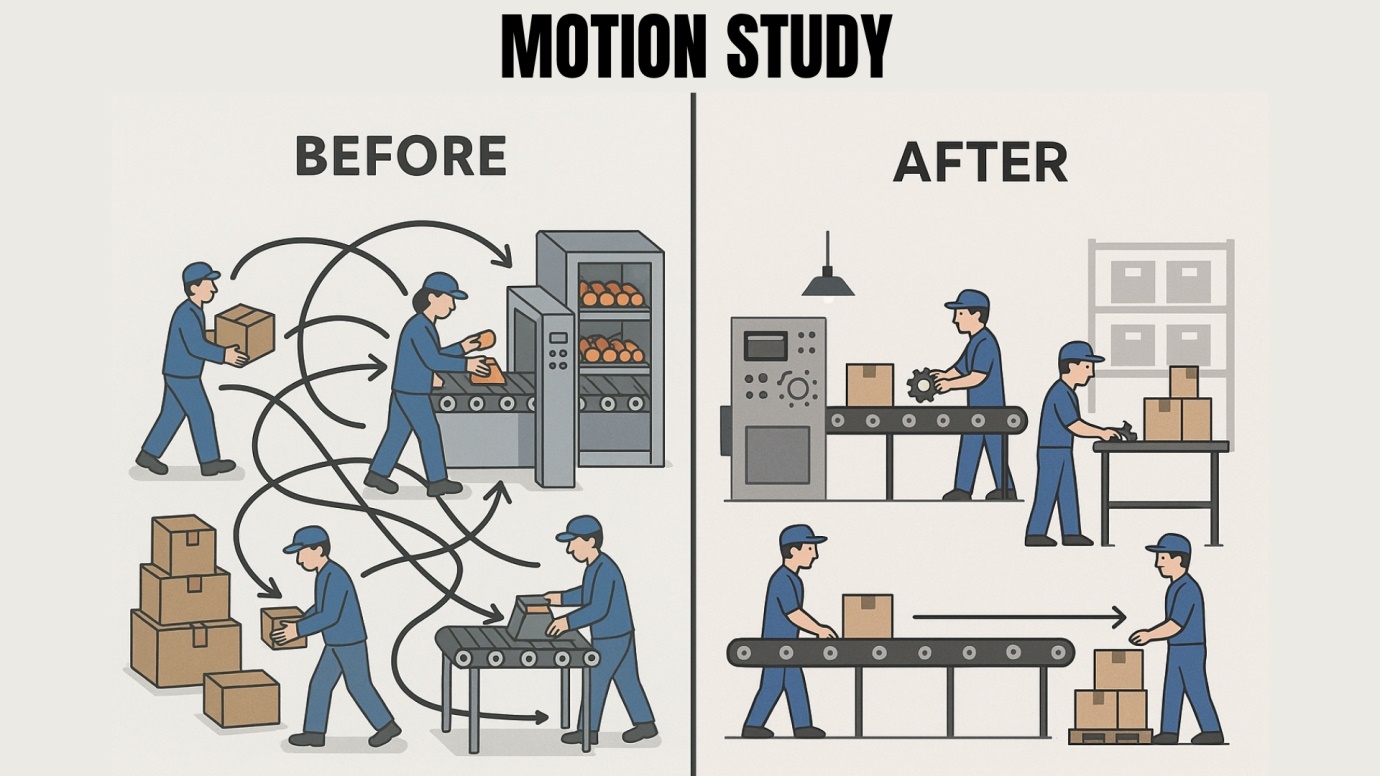
What Exactly is Motion Study?
At its core, motion study is a systematic technique used to observe, record, and analyze every individual movement required to complete a task. By breaking down a job into its smallest elements, motion study helps organizations understand how work actually gets done on the shop floor or in an office setting.
Whether you’re involved in motion study in industrial engineering or applying motion study in management, the principles remain the same: examine each motion, determine its necessity, and find better ways to perform it.
Why is this so valuable?
Every small movement — no matter how minor — contributes to time, energy, and cost. When unnecessary motions are eliminated, the result is a smoother workflow, less physical strain on workers, and a significant boost in overall efficiency.
Key aspects of a successful motion study:
- Analyze each step critically: In motion study, tasks are broken into tiny elements such as reach, grasp, move, and release.
- Eliminate wasteful motions: The goal is to remove any action that doesn’t add value.
- Simplify necessary motions: Redesign work methods so the required movements are as easy and natural as possible.
- Reduce worker fatigue: Well-designed movements minimize strain and awkward postures, a core principle of motion study in industrial engineering.
- Standardize best practices: Findings from motion study in management ensure that the “one best way” becomes the standard for everyone performing the task.
In a manufacturing environment, for example, motion study might reveal that tools should be positioned closer to reduce unnecessary reaching. Or it might identify that a worker’s repetitive twisting motion could be eliminated through a simple workstation redesign. These small improvements add up to major savings and safer, more ergonomic workplaces.
In short, motion study is all about working smarter. By applying the principles of motion study in industrial engineering and motion study in management, businesses can create efficient, productive processes that benefit both people and profit.
The History and Evolution of Motion Study
The roots of motion study go back to the early 20th century, when two visionary industrial engineers — Frank B. Gilbreth and Lillian M. Gilbreth — set out to transform how work was performed. Known today as the pioneers of motion study, the Gilbreths believed that every task could be broken down into its smallest units to identify the most efficient way to complete it.

One of their remarkable contributions was the concept of therbligs — a term cleverly derived by rearranging the letters of their name. Therbligs represent the 17 fundamental motions, such as reach, grasp, move, and hold, that make up any manual task. By analyzing these tiny motions, the Gilbreths laid the foundation for what would become a cornerstone of motion study in management and industrial engineering.
While the Gilbreths focused deeply on the motions involved in work, their contemporary, Frederick Winslow Taylor, developed the idea of time study, which focused on measuring the duration of tasks to set performance standards. Together, these two ideas merged into the well-known practice of time and motion study, which still forms a critical part of motion study in management today.
Key milestones in the evolution of motion study:
- Scientific Management: The Gilbreths’ work on therbligs and Taylor’s time study formed the basis of early motion study in management, shaping the first era of scientific management.
- Industrial Engineering Foundations: Over time, these ideas were embedded into the fabric of motion study practices used in manufacturing, assembly lines, and production management.
- Modern Lean and Ergonomics: Today, the principles of motion study are at the heart of lean manufacturing, continuous improvement, and workplace ergonomics. Companies apply these time-tested ideas to reduce waste, design better workflows, and create safer work environments.
From the simple yet powerful observations of the Gilbreths to the sophisticated tools used in today’s factories, motion study has come a long way — but its core purpose remains the same: to make work more efficient, effective, and human-centered.
Principles of Motion Economy
A successful motion study goes beyond just analyzing how tasks are done — it also applies a proven set of guidelines called the principles of motion economy. These principles form the backbone of work motion study and ensure that every movement, tool placement, and workstation layout contributes to maximum efficiency with minimum effort.
Originally developed by pioneers like Frank and Lillian Gilbreth, these principles are now deeply embedded in motion study in industrial engineering and widely used in modern factories, warehouses, and service operations. Whether applied on a shop floor or in an office, they help organizations practicing motion study in management achieve real, measurable improvements.
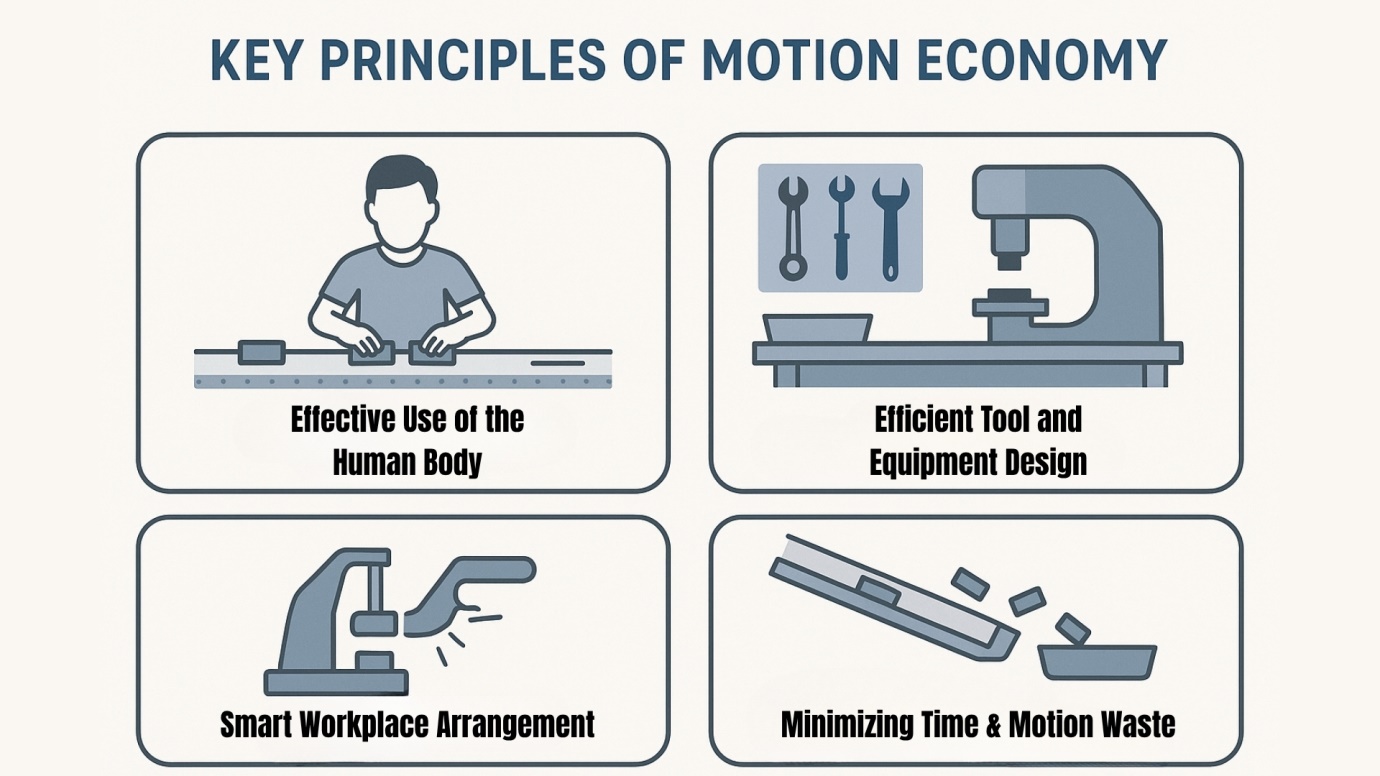
Key Principles of Motion Economy:
Effective Use of the Human Body
-
Workers should use both hands simultaneously and symmetrically when possible. Movements should be smooth and natural, avoiding unnecessary stretching or awkward postures.
Example: In an assembly line applying work motion study, parts are positioned at a comfortable height to reduce bending and reaching.
Smart Workplace Arrangement
-
Everything needed for a task should have a fixed, easily accessible place. Tools and materials should be arranged close to the point of use, ideally within the normal reach zone.
Example: In motion study, a well-organized workstation might include a shadow board for tools, so operators never waste time searching for them.
Efficient Tool and Equipment Design
-
Tools should be designed to minimize the effort required to use them. Jigs, fixtures, and foot-operated controls can free up the hands for other tasks, boosting productivity.
Example: A foot pedal added to a stamping machine, identified through motion study in industrial engineering, frees the operator’s hands to handle materials continuously.
Minimizing Time and Motion Waste
-
Combining tasks, using gravity to move materials, and pre-positioning parts can reduce non-value-adding motions.
Example: A simple gravity feed chute can replace the need for workers to lift heavy bins repeatedly — a classic solution from motion study in management.
By following these timeless principles, companies ensure that work motion study isn’t just theoretical — it becomes a practical tool for creating ergonomic, productive, and safer workplaces.
How Motion Study is Conducted
Conducting a successful motion study requires a systematic, step-by-step approach that leaves no detail overlooked. Whether you’re improving a factory line or a service workflow, following a structured process ensures that your work motion study delivers real results — not just surface-level tweaks.
Over the years, industries have refined this method into clear stages that combine observation, analysis, and practical redesign. This process is widely recognized in motion study in management, where improving how work is done directly impacts productivity, cost savings, and employee well-being.
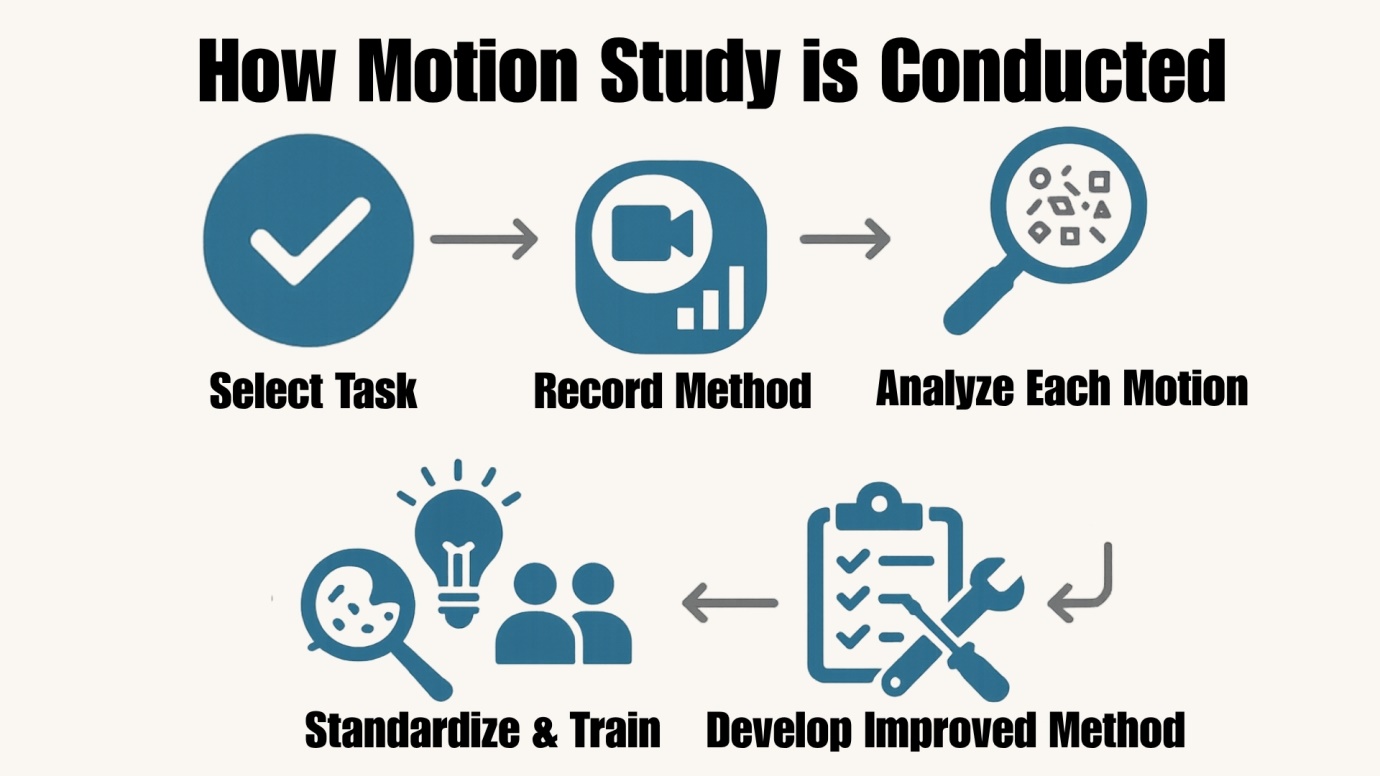
Here’s how a typical motion study is conducted:
Step 1: Select the Task
Begin by choosing a specific task or process that has potential for improvement. This could be a repetitive manual operation, an assembly activity, or any workflow where wasted motion may exist.
Step 2: Record the Current Method
Accurate recording is the foundation of an effective work motion study. Observe the task in real time, take detailed notes, and use tools like video analysis or motion picture photography to capture every movement clearly. Charts and diagrams, such as flow process charts or therblig charts, are often used to visualize the sequence of motions.
Step 3: Analyze Each Motion
Next, break the task down into its smallest elements. Study each motion critically to identify which ones add value and which do not. This is where the power of motion study in management comes into play: unnecessary or awkward movements can now be highlighted and targeted for elimination or redesign.
Step 4: Develop the Improved Method
Using the insights gained, design a more efficient way to perform the task. Apply the principles of motion economy to ensure movements are smooth, ergonomic, and logical. For example, tools might be repositioned closer to reduce reaching, or jigs may be introduced to free up the operator’s hands.
Step 5: Standardize and Train
Once the new method is developed, it’s vital to document it as a standard practice. Workers should be trained in the improved method to ensure consistency and long-term success. This step transforms a single motion study into an ongoing part of your company’s operational excellence strategy.
By following this structured approach, organizations can make work motion study and motion study in management practical, actionable, and impactful. The result is not just a more efficient process, but a safer and more satisfying working environment.
Benefits of Implementing Motion Study
Putting motion study into practice isn’t just about fine-tuning tasks — it’s about unlocking hidden value across every aspect of your operations. When done right, motion study in management, production, and operations can deliver measurable benefits that ripple throughout your business, from the shop floor to the bottom line.
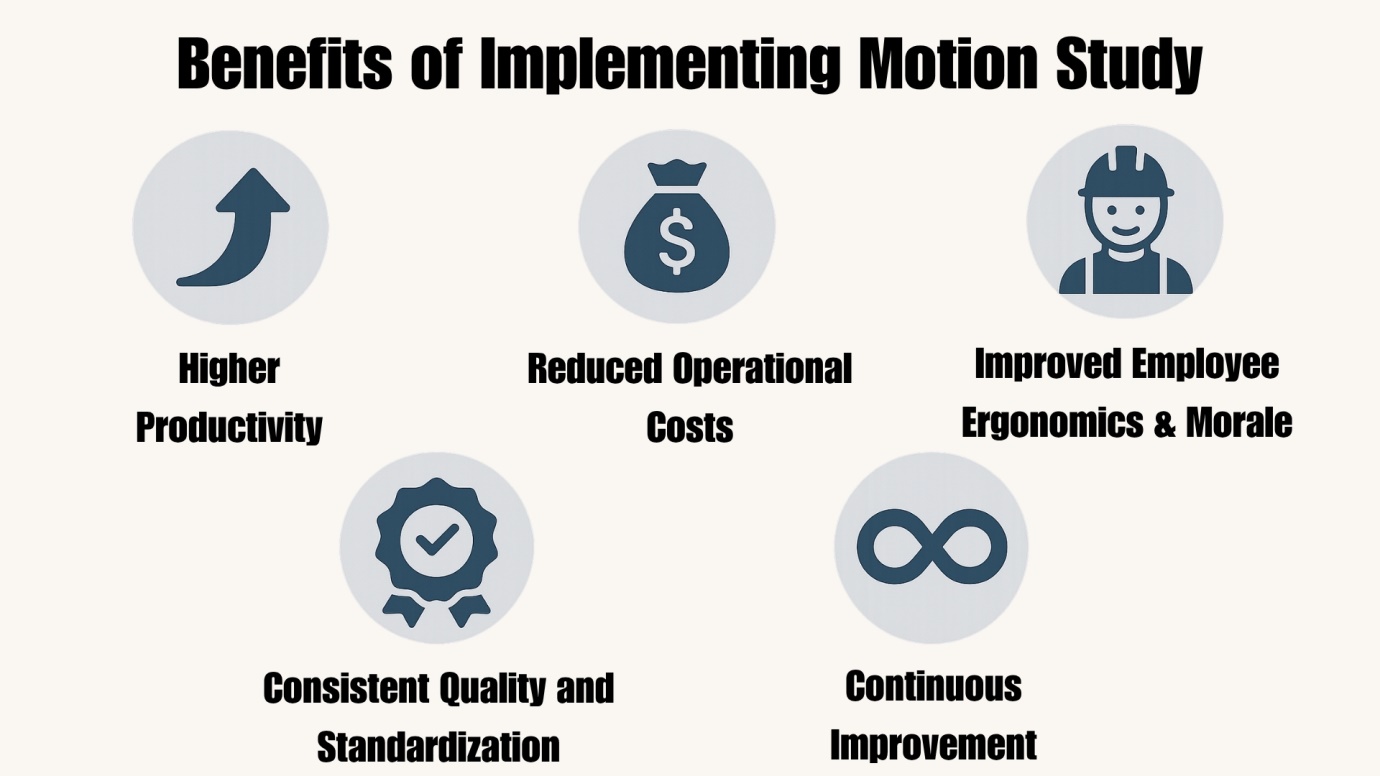
Here’s how your business can benefit from implementing motion study:
1. Higher Productivity
One of the most significant advantages of motion study is its ability to boost output without increasing workload. By analyzing and refining every movement, workers can complete tasks faster and with less effort. In motion study in operations management, this leads to streamlined workflows, shorter cycle times, and more efficient resource utilization.
2. Reduced Operational Costs
Every unnecessary motion costs time and money. By applying motion study in production management, businesses identify and eliminate wasteful actions that drain resources. The result? Lower labor costs, reduced machine wear and tear, and fewer delays — all contributing to healthier profit margins.
3. Improved Employee Ergonomics and Morale
A well-conducted motion study always considers the human factor. Optimized motions mean less repetitive strain, awkward postures, and fatigue. When employees experience better ergonomics and more comfortable workstations, their morale and job satisfaction naturally rise. This focus on people is why motion study in management remains relevant even in today’s automated world.
4. Consistent Quality and Standardization
With a standardized “best method” in place, the variability between workers and shifts is minimized. Motion study ensures that every task is done the same efficient way every time, which leads to better product quality and fewer defects. For companies that practice motion study in production management, this consistency is vital for meeting customer expectations and maintaining brand reputation.
5. Basis for Continuous Improvement
Motion study in operations management lays the groundwork for a culture of continuous improvement. Once teams see the value of analyzing and refining workflows, they become more engaged in looking for other opportunities to optimize processes. This mindset helps companies stay competitive in fast-changing markets.
In short, the benefits of motion study extend far beyond the obvious cost savings — they create a healthier, more efficient, and more adaptable work environment. At Sugoya India, we help businesses embed these principles into everyday operations, ensuring that motion study in management, production, and operations is not just a one-time effort, but a long-term strategy for sustainable success.
Motion Study in the Modern Era
While the principles of motion study were born in the early 20th century, they have never been more relevant than they are today. In a world where speed, precision, and worker well-being are critical, modern industries rely on motion study in operations management and production environments to stay competitive and resilient.
One of the biggest shifts in recent decades is the integration of motion study into broader, proven process improvement frameworks. Here’s how they work together:
Lean Management
Modern manufacturers use motion study in production management alongside lean management principles. Lean helps identify and eliminate obvious waste, while motion study digs deeper to remove hidden inefficiencies in every task. For a deeper dive, read our full blog on Lean management.
Six Sigma
Six Sigma complements motion study by using statistical tools to reduce process variation. Once tasks are standardized through motion study, Six Sigma ensures they stay consistent, reliable, and high quality. Explore more in our dedicated Six Sigma blog.
How They Work Together:
This powerful synergy works like this:
- Lean identifies and removes unnecessary steps.
- Six Sigma stabilizes processes and reduces defects.
- Motion study fine-tunes every motion for smooth, ergonomic, and repeatable work.
By combining the detailed insights of motion study in production management with proven lean and Six Sigma tools, companies achieve breakthrough results in efficiency, cost savings, and workplace safety.
Another key aspect of motion study in operations management today is its focus on workplace ergonomics. With rising awareness of occupational health & safety, businesses use modern motion study to design jobs that reduce strain and repetitive stress injuries. Smarter workstations and ergonomic layouts not only protect employees but also keep productivity high and turnover low.
How technology is transforming motion study:
Modern digital tools have supercharged the capabilities of motion study:
- High-definition video analysis: Makes it easy to record, slow down, and study tasks frame by frame.
- Motion-capture software: Captures body movements in 3D, pinpointing awkward postures & repetitive motions that lead to injuries.
- Data analytics: Helps interpret large sets of motion data to spot trends that may not be obvious in real time.
Looking ahead, motion study in production management is evolving hand in hand with Industry 4.0. Smart sensors, real-time data collection, and AI-assisted analysis are paving the way for predictive motion study, where potential inefficiencies are flagged automatically before they become bottlenecks. Robotics and cobots (collaborative robots) are also benefiting from motion analysis — they are now programmed with the best movements to work safely and efficiently alongside human workers.
In the modern era, motion study is no longer just about stopwatch timing and clipboards; it’s about using cutting-edge technology to achieve the same timeless goal: more efficient, ergonomic, and sustainable work.
Why It Matters & How Sugoya India Can Help
In today’s highly competitive industrial world, even the smallest improvements uncovered through motion study can translate into significant cost savings and measurable gains in efficiency. When businesses take the time to refine each step, eliminate wasted effort, and create ergonomic workflows, the cumulative effect can transform profitability, worker safety, and overall output.
At Sugoya India, we understand the power of motion study in operations management and motion study in production management. Our team brings decades of experience in industrial engineering, lean manufacturing, and process optimization — helping companies across diverse industries unlock their hidden potential.
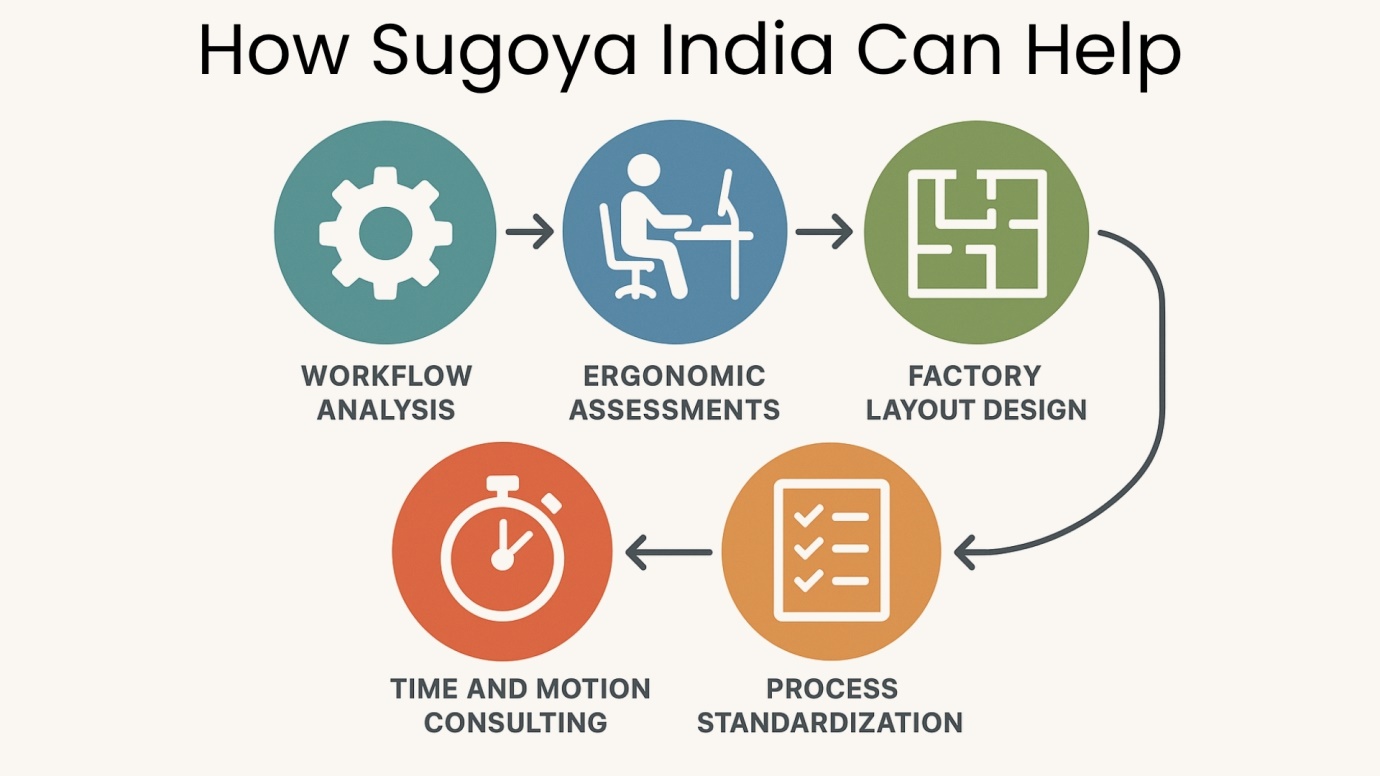
How Sugoya India can support your motion study journey:
Our comprehensive solutions cover every aspect of modern motion study, tailored to your unique challenges and goals:
- Workflow Analysis: Detailed observation and recording of tasks to identify wasted motions and streamline steps.
- Ergonomic Assessments: Applying principles of motion study to design workstations that reduce strain and improve comfort.
- Factory Layout Design: Designing optimal facility layouts that minimize unnecessary movement of people and materials.
- Process Standardization: Developing clear, repeatable methods to maintain consistent quality and productivity.
- Time and Motion Consulting: Combining traditional and digital tools to conduct precise motion study in operations management and deliver actionable recommendations. For a deeper look at how different techniques compare, check out our detailed blog on Comparison Of Various Time and Motion Study.
Over the years, Sugoya India has successfully delivered projects ranging from single-workstation improvements to full-scale motion study in production management initiatives for major manufacturing plants. Our approach is always data-driven, collaborative, and customized — because we know that every business faces different operational challenges.
When you partner with us, you gain more than just consultants — you gain a team dedicated to building long-term efficiency and resilience into your operations.
Let’s identify where hidden inefficiencies are costing you time and money. Reach out to Sugoya India today for a customized motion study consultation or on-site audit. Together, we’ll design smarter, leaner, and more productive workflows for a stronger future.
FAQs
A. Motion study is the systematic analysis of every movement involved in a task to identify and eliminate wasteful actions. It’s vital in today’s industries because it improves efficiency, reduces costs, and enhances workplace ergonomics.
A. While motion study focuses on analyzing the movements needed to complete a task, time study measures how long each task takes. Together, they form work and motion study, which gives businesses a complete view of how to improve workflows.
A. Motion study in operations management helps streamline workflows, standardize best practices, and reduce operational waste, leading to smoother production and lower costs.
A. Motion study in production management ensures that tasks on the production line are performed in the most efficient and ergonomic way, improving output quality and worker safety.
A. The key principles of work motion study include effective use of the human body, smart workplace arrangement, efficient tool design, and minimizing wasted motions.
A. The key principles of work motion study include effective use of the human body, smart workplace arrangement, efficient tool design, and minimizing wasted motions.
A. Motion study in industrial engineering is used to design workstations, optimize factory layouts, and implement lean workflows that reduce waste and improve employee ergonomics. To see how our experts put these ideas into practice, explore our full range of industrial engineering services by Sugoya India.
A. Sugoya India offers end-to-end support for motion study, including workflow analysis, ergonomic assessments, factory layout design, and time and motion study consulting to help businesses maximize efficiency.
A. Absolutely! Even with automation, motion study in management remains essential to ensure humans and machines work together efficiently and safely — especially with the rise of Industry 4.0.
A. A good motion study creates a baseline for standardizing work and provides data for ongoing process optimization, which is central to lean and continuous improvement initiatives.
A. Start by identifying tasks that can benefit from work and motion study, then record, analyze, and redesign the workflow. For expert help, contact Sugoya India to run a tailored motion study in operations management or in production management project.
Conclusion
Over a century since its introduction, motion study remains one of the most powerful tools for driving efficiency, improving productivity, and creating safer, more ergonomic workplaces. Its core principle — that even the smallest wasted movement adds up to significant time and cost — continues to shape how successful businesses operate today.
Whether you’re refining a single workstation or transforming an entire production line, motion study gives you the clarity to see where waste hides and how to eliminate it. By breaking tasks down to their smallest elements, analyzing every motion, and applying practical improvements, your organization can work smarter, not just harder.
At Sugoya India, we believe that motion study is not just an old industrial engineering technique — it’s a timeless strategy that empowers businesses to stay lean, competitive, and resilient in an ever-evolving market.
If you’re ready to discover how motion study can optimize your processes and unlock new levels of performance, we’re here to help. Reach out to Sugoya India today to learn more about our tailored industrial process optimization services — and let’s build your next efficiency breakthrough together.
Contact us today and take the first step towards a smarter, leaner, and more productive future with trusted industrial engineering experts by your side.
Ready to explore our expertise? Discover the right consultation for your business — visit our Homepage for more information and dedicated consultation support.

